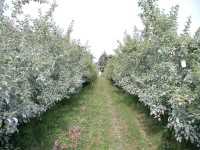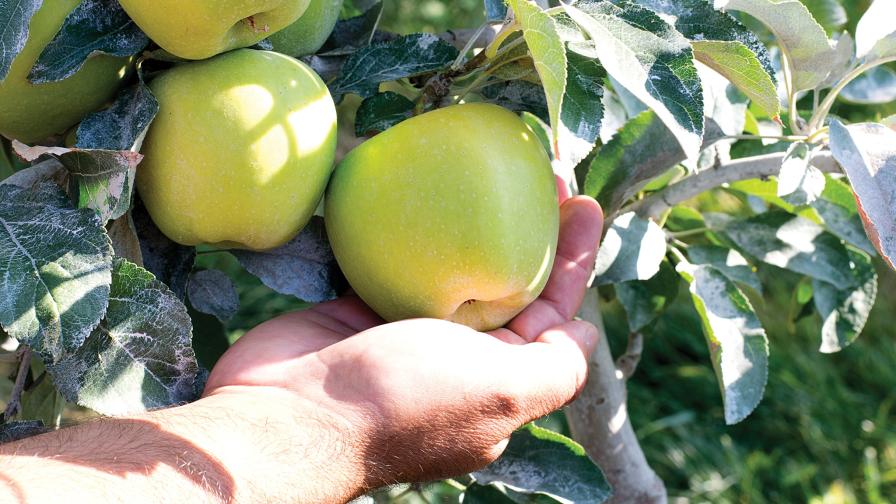Growing The Eastern Organic Apple Is Possible

Organic apple growing has often been linked with the ideal conditions of Washington and California. However, growing organic apples is possible in the East as Greg Peck, assistant professor of horticulture at Virginia Tech University, is quick to point out.
“We can grow organic apples in the Eastern U.S. But with frequent rainfall and overall high humidity during the growing season, organic apple production is more challenging and more complex here in the East than in regions with dry summers, such as Washington State and California,” says Peck. “Plus, apple growers will likely contend with more than 50 direct and indirect arthropod pests, as well as more than 20 plant diseases without the aid of synthetically derived pesticides.”
Not Without Challenges
Peck sees apple scab as the largest deterrent of Eastern apple growers adopting organic apple production. He urges organic apple growers to select disease-resistant cultivars such as Liberty, GoldRush, Enterprise, Pristine, and Crimson Crisp.
“(Disease-resistant) apple cultivars have been bred using traditional crossing methods to contain a gene called ‘Vf’ which originated from a crabapple (Malus floribunda) and conveys systemic protection against apple scab,” says Peck. “However, these cultivars don’t have widespread consumer recognition. And, the Vf gene is losing its effectiveness. Certain strains of scab are beginning to successfully infect disease-resistant cultivars.”
Without disease-resistant cultivars, Peck notes that growers will resort to sulfur, lime sulfur, and copper for scab control. “Each of which poses potential negative effects on the environment and/or farm workers,” says Peck.
Invasive pests are also an issue for growers. Peck urges growers to adopt a management system using pheromone mating disruptions, kaolin clay, Bt, granulosis virus, and spinosad. He also suggests using pyrethrums and neem oil, but on a lessor scale.
“Many organic apple growers use kaolin clay (Surround) to white wash their orchards. The clay particles deter (but generally don’t kill) insect pests by several different modes of action. To get an adequate level of clay protection on the trees in a wet year, growers will need to spray several hundred pounds per acre of the material onto their trees,” says Peck. “At the end of the season, growers are then met with the challenge of washing the clay off of the apples so the white residue doesn’t turn off consumers.”
Success Starts At Planting
Disease-resistant rootstocks are also an important part of successful organic apple cultivation. Peck urges growers to plant high-density orchards with disease-restant dwarfing rootstocks that also have high nitrogen use efficiency. Smaller trees will allow for good spray penetration and are more accessible for doing tasks such as hand thinning.
“Many organic growers that I’ve spoken with prefer to plant trees with larger rootstocks because these trees tend to withstand more damage from insects and diseases and are better able to compete with weeds for nutrients and water. However, dwarfing rootstocks planted in higher density orchards (upwards of 1,000 trees per acre) have been shown to be more profitable in conventional systems, and I think these plantings can be successful in organic systems, too,” says Peck. “High-density plantings use shorter trees, which make hand operations such as fruit thinning and harvesting easier, and they have a more open canopy, which improves spray coverage and decreases the humidity and drying times—this in turn helps with disease and insect control.”
In order for growers to have a successful organic operation in the East, Peck urges growers to develop an organic system from the ground up. This includes mechanical weed control, mechanical thinning, and crop load management with lime sulfur.
“Successful organic orchardists in the East employ a systems-level thinking about their orchard. They understand that every management choice they make will impact several other aspects of the orchard agroecosystem, if not the whole operation,” says Peck. “(They) also tend to have a clear plan about their orchard from the beginning. This includes everything from site selection and cultivar/rootstock choices all the way to their marketing strategy.”
Sidebar:
Do Your Homework
Before adopting an organic program on a farm, Eastern apple growers are urged to take their time, do their homework, and plan the production prior to planting.
“It’s just too complicated and risky to jump in without taking the time to plan the whole operation. Talk to other growers, get in touch with your land-grant university’s Extension office to find out what resources they have available, and read as much as possible.”
A resource for growers is “A Grower’s Guide to Organic Apples,” co-authored by Peck and Ian Merwin, professor of horticulture at Cornell University.
“(The book )was funded by a grant from the New York State Department of Agriculture and Markets. The Guide was written for the commercial organic grower and is available for free at: http://www.nysipm.cornell.edu/organic_guide/,” says Peck.










